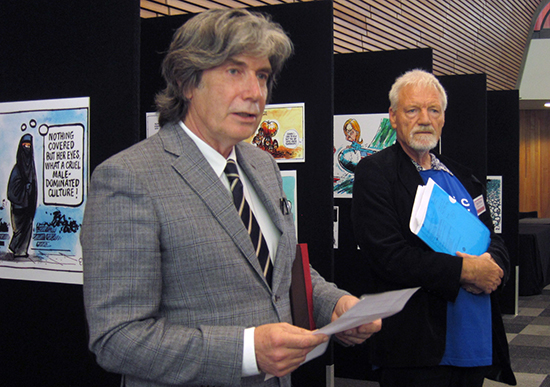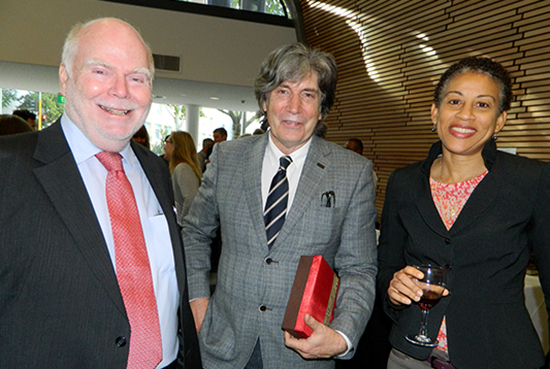AUCKLAND (Pacific Media Centre/Pacific Media Watch): Pacific Journalism Review celebrated 20 years of publishing in style last week with a three-day Asia-Pacific political media conference, a tapas and drinks celebration and the unveiling of a mega cartoon featuring editorial characters.
Vice-Chancellor Derek McCormack congratulated the research journal’s founding editor, professor David Robie, and his team for reaching such a milestone.
Australian Journalism Review editor Professor Ian Richards also spoke at the birthday celebration, saying how the journal’s unique character for the Asia-Pacific region had been beneficial for the research culture in both Australia and New Zealand as well as the Pacific.
Many current and past co-editors and contributors also praised the journal, some sending messages from afar, such as Vanuatu-based photojournalist Ben Bohane, communications director for the Pacific Institute of Public Policy, who is featured with a portfolio of “The Black Islands” photographs in the latest edition of PJR.
“Congratulations for all your hard work over 20 years with the journal and all your other initiatives which have contributed hugely to building up Pacific journalism,” said Bohane, one of the editorial personalities featured in the cartoon by Malcolm Evans, who has created many of PJR’s distinctive covers.
Evans, a former NZ cartoonist of the year, had both a digital and print exhibition of his cartoons on display at the conference.
Vice-president Dr Angela Romano of the Journalism Education and Research Association of Australia (JERAA) also congratulated the journal.
‘Superb achievement’
“Congratulations to David and everyone else associated with the latest issue of Pacific Journalism Review. It’s another great edition, and a superb achievement to have reached the 20-year milestone,” she said.
Shailendra Singh of the University of the South Pacific, where PJR was based for five years, praised the journal’s support for emerging Pacific media researchers.
“PJR has played a critical role providing opportunities and space for upcoming Pacific Island academics and journalists. For me it was thrilling to see USP’s Eliki Drugunalevu and Republika editor Ricardo Morris on the PJR programme this year,” he said.

Speaking about the last two decades, Dr Robie said a research paper about the journal presented to the conference by Dr Lee Duffield of Queensland University of Technology had provided statistics on the achievements.
This would be published as a peer-reviewed document in the special birthday edition of PJR next May.
But Dr Robie wanted to “acknowledge a few people who have contributed to our vaka on this journey”.
“As I noted at the opening of the conference, as founding editor, perhaps I can be excused for being rather biased, but I do believe that PJR has quite a unique character,” he said.
“It is more than just a research journal. It has given strong support to investigative journalism, photojournalism and political cartooning in its two decades, which have all been strongly reflected in the character of the journal.”
‘Doing justice’
Many people had helped along the way and he wanted to “do justice” to their contribution.
“First of all, I must acknowledge the Australian Journalism Review which is almost double the age of PJR because this is where I first got the inspiration. While I was head of journalism at the University of Papua New Guinea in 1993 I was really frustrated at the lack of good Pacific-specific media and journalism literature and research,” Dr Robie said.
“So I looked longingly at AJR, and even contributed to it, and I also looked longingly at the London-based Index on Censorship.
“I thought, ‘Why not? We can do that’. And so I got the University of Papua New Guinea Press on board and started the first edition of PJR in November 1994.
“So this really is the actual birthday edition, although you wouldn’t know it looking at the cover. But the editorial does acknowledge the birthday.
“The real special anniversary edition with a larger book format will be in May next year.”
AJR’s John Henningham, Mark Pearson – also a regular contributor and editorial board adviser – and Ian Richards had been journal mentors. It was appropriate that Professor Ian Richards had agreed to speak at the celebration.

Biggest inspiration
“But the biggest inspiration I have had over many years is Professor Wendy Bacon, who has been co-editor and been involved over many issues from right back in the Papua New Guinea days,” he said.
She had also started the Frontline investigative journalism and “journalism as research” section.
Chris Nash had also been a major contributor and co-editor, along with Trevor Cullen.
The idea for Lee Duffield’s PJR 20 years audit paper had evolved from “a fine submission” he made about the journal to the Excellence in Research in Australia (ERA) national audit in 2010.
After five years in PNG and five years in Fiji, the journal relocated to AUT where it had taken on a completely new lease of life. But it had retained the USP links from Fiji with both Pat Craddock and Shailendra Singh being major contributors.
“At AUT, Professor Barry King was the critical supporter who got us going in 2003, and also Allison Oosterman and Valia Papoutsaki; and more recently Philip Cass from Unitec – but Philip was previously among the early contributors. He was born in Wewak, PNG,” Dr Robie said.
He singled out three people who were not on the editorial board, or who had editorial roles, for special mention. They were Tui O’Sullivan, a key PJR supporter at AUT; School of Communication Studies manager Kevin Upton; and Tony Murrow of Little Island Press who redesigned the PJR website in 2011.
None of this could have been done without the support of the school, faculty – the dean, Professor Desna Jury, and associate professor Tony Clear – and university, and also the Pacific Media Centre board members, including associate professor Camille Nakhid.
Designer and video
He especially acknowledged unpaid organiser Del Abcede, “who has worked tirelessly on the journal for many years as the designer – as you saw in the video The Life of Pacific Journalism Review – and keeping me sane.”
For several years she had coordinated the mailing lists, inventory and many other essential tasks of PJR.
“Frankly, without her voluntary work I would have found it really difficult to publish the journal all these years,” he said.
“Finally, in the very first edition of the PJR, I wrote in the editorial:
“There is surprisingly little reflective journalism or analysis of the state of the media today in the Pacific, or of issues such as freedom of information, freedom of expression, ethics, ownership ….
“PJR will combine the characteristics of an academic journal and a professional industry publication. It will include both research and articles of general interest by journalists and media people – anything that will enhance the quality of journalism and the study of it in the South Pacific will be considered for publication by the editorial board.”
“Our first edition dealt with threats of secession from the state of Papua New Guinea by the Islands Region provinces – and censorship. Over the years, PJR authors and researchers have tackled the Sandline mercenary crisis and the Bougainville war in Papua New Guinea, two coups in Fiji, West Papuan repression and now climate change.
“I believe that in 20 years we have achieved what we set out to do, being a critical conscience of Asia-Pacific society through a media prism, and now look forward to the future challenges.”
Fraser pays tribute
This work is licensed under a Creative Commons Attribution-NonCommercial 3.0 New Zealand Licence.
PJR2014
Media freedoms, human rights and doco feature in PJR conference
Grim reminders of price paid by journalists in Asia-Pacific
PMC, RSJ call for action on Ampatuan massacre trial
Fiji media still face 'noose around neck' challenges
Max Stahl's livestreaming
Walter Fraser's opening speech
Max Stahl tells of Santa Cruz massacre on Radio NZ's Sunday
Green MP calls for 'rigorous documentation' Pacific sequel to Hot Air film
PJR2014 on Storify
PJR website




